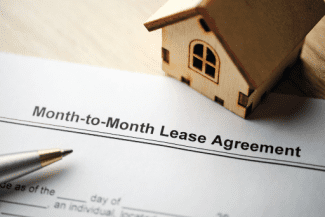What Are the Benefits of Renting Month to Month?
Pros and Cons for Tenants and Landlords
While most landlords sign yearly lease agreements with their tenants, some landlords will also offer an option to rent month to month. This situation has its pros and cons. Learn the benefits and negatives of renting month to month for both landlords and tenants.
Benefits of Month to Month Rentals for Tenants
Sometimes tenants need a place to stay but do not want a long term commitment. For these tenants, finding a landlord who is willing to sign a month to month rental agreement is ideal. The benefits for a tenant include:

- Short Notice to Move– Depending on state law and the terms of the rental agreement the tenant has signed with the landlord, a tenant must give the landlord written notice before moving out of the rental. The amount of notice required usually ranges from 30 days to 60 days prior to desired move out day.
- No Specific End Date– Unlike lease agreements, month to month agreements do not have a specific end date. Therefore, month to month tenants will not face a penalty for breaking a lease early. To end the month to month agreement, the tenant just has to give the landlord the appropriate amount of written notice.
- Can Look for a Home– Month to month rentals give tenants a short term place to live when they are looking to buy a home. Once they have a closing date on the home, they can give the landlord the required notice to move out of the rental.
- Short Term Rent While Renovating a Home– Sometimes current homeowners have to move out of their home temporarily if they are doing extensive renovations on their home, such as an addition. These tenants are looking for a place to stay for a few weeks or a few months.
Negatives of Month to Month Rental for Tenants
While there are many benefits to a month to month rental agreement, there are also some negatives to this type of living arrangement. Here are the cons of month to month agreements for tenants.
- Higher Rent– Landlords often charge higher rent for month to month agreements than they would for a yearly lease. Month to month agreements are riskier for the landlord because the tenant often only has to give 30 days’ notice to move. The higher rent helps the landlord offset thecost of an anticipated vacancy.
- Landlord Can End Rental Agreement– A tenant is not the only one who can end a rental agreement. A landlord can also end the rental agreement as long as he or she gives the tenant the required amount of written notice. There is less stability in a month to month agreement and the tenant needs to understand that they might need to look for a new place to live on a moment’s notice.
Need a Lease Agreement?
Access 150+ state-specific legal landlord forms, including a lease.
Benefits of Month to Month Rentals for Landlords
While most landlords prefer to sign yearly lease agreements with their tenants, there are several benefits of month to month agreements that landlords should be aware of. These include:
- Can Get a Tenant Out Quickly– In traditional lease agreements, unless a tenant breaches the lease agreement and you file for an eviction, you will have to wait until the lease expires to get a tenant out of your rental property. In month to month agreements, you can give a tenant as little as 30 days’ notice, depending on state law, to get the tenant to move out of the rental.
- Charge Higher Rents– There are a limited number of landlords who are willing to sign a month to month agreement with a tenant. Due to the limited supply, you will likely be able to charge your tenant more to live in your rental. This higher rent will also help to offset vacancy costs if you are unable to quickly find a new tenant when the current tenant moves out of the rental.
- Can Increase Rent– Another benefit of month to month agreements is the ability to increase rent often. State laws may vary, but landlords typically only need to give the tenant 30 days’ written notice of a desired rent increase. If the tenant agrees to the rent increase, the landlord will be collecting a higher rent, if the tenant declines the rent increase and gives proper notice to move, the landlord will collect no additional rent until he or she is able to fill the vacancy.
Negatives of Month to Month Rentals for Landlords
Month to month agreements can be a lot of work for a landlord. Here are the negatives to consider:
- Learning Curve With New Tenant– When you sign a long lease with a tenant, you are dealing with a known quantity. You and the tenant have gotten used to each other and each understands the roles and responsibilities. When you place a new tenant in the property, even with proper screening procedures, there is a learning curve as each party gets used to the situation. You may deal with maintenance complaints, noise complaints, damage or nonpayment.
- Prepare for Vacancy- Since a tenant can move out with as little as a month’s notice, you must always be prepared for a vacancy at your rental. If you rely on this income, it can be very stressful finding a quality tenant quickly. Most prospective tenants will have to give their landlord at least 30 days’ notice to move out of their current rental, so you will have to post ads and be able to show the apartment as soon as you find out that you will have a vacancy.
Source: liveaboutdotcom















 Accessibility
Accessibility